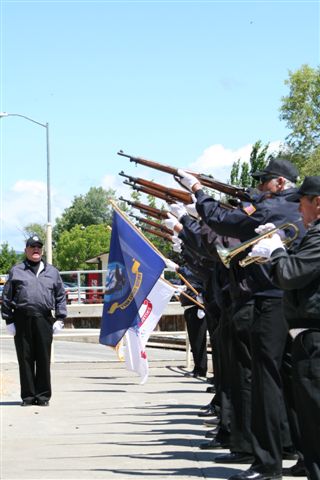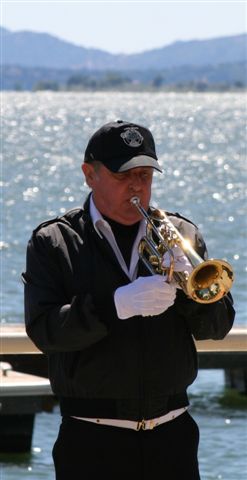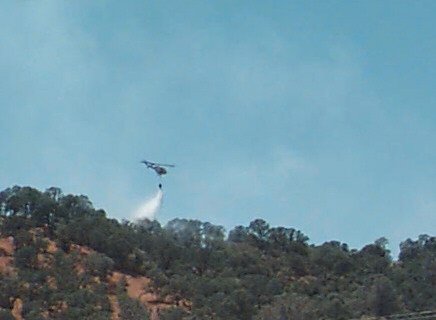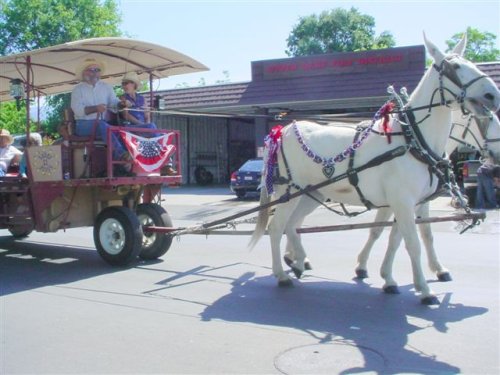
Jim Harris, now 83, was 19 when he took part in the D-Day invasion. Photo by Ginny Craven.
LAKEPORT – “OK, let's go.”
That was the final order from General Dwight Eisenhower, supreme commander of the Allied Expeditionary Force, on the morning of June 5, 1944, after receiving word that a few days' break in the North Atlantic's stormy weather was forecast.
That, Eisenhower decided, was enough time to carry out what would become the greatest invasion in military history.
The following day, an estimated 150,000 men would invade Normandy by land, sea and air, an effort that included 5,000 ships and 11,000 airplanes.
On Wednesday morning, veterans gathered at the Pearl Harbor memorial flagstaff in Lakeport's Library Park to remember that day 63 years ago.
Among those gathered was a man whose boots actually touched the sands of Omaha Beach, where US forces were concentrated during the invasion. That beach would later be called “Bloody Omaha,” because or the estimated 2,200 casualties the American forces took there under the Germans' fierce defenses and the coast's high cliffs.
Allied forces overall suffered about 10,000 casualties on D-Day, according to historical reports.
Ronnie Bogner was the master of ceremonies for Wednesday morning's commemoration, which featured the singing of the National Anthem by former Miss Lake County Saundra Combs, and a three-volley salute and Taps by the United Veterans Council Military Funeral Honors Team.
Sea Scout Ship Whisper Bosun Desmond O'Connor and Mate Trina Lane helped raise the American flag. Also in attendance were members of the California Highway Patrol and Lakeport Police. (For a full picture gallery of the ceremonies, visit our Gallery section.)
Captain Woody Hughes led the invocation and was a featured event speaker.
Hughes emphasized the Normandy Invasion's importance in breaking Adolf Hitler's stranglehold on Europe.
The invasion, Hughes noted, was the first invasion to cross the English Channel in nine centuries.
He shared the story of visiting Devon, England, where he met Ken Small, who helped discover the untold story of Slapton Sands, a practice invasion that took place along the English coast in April 1944.
While walking Devon's beaches, Small – who had retired and moved to the area, where he bought a a guest house – discovered US military artifacts and began to write the government and talk to locals. During the course of his search he helped locate a US Sherman tank underwater just off the coast, on which fishermen often hooked their nets.
During the Slapton Sands practice invasion, two German torpedo boats appeared and attacked the destroyer flotilla, according to a US Navy history. What followed was the death of 749 men.
Those battle dead are part of the D-Day story, which Hughes said is important to remember.
Following Hughes was Lucerne resident “Gypsy” Jim Harris, 83, who has witnessed more history than most people have read about.
Harris has the distinction of having been at Pearl Harbor at the start of the war and at D-Day toward the war's end. He grew up in Oakland and joined the Navy at age 15. At 17 he was present when Pearl Harbor was attacked by the Japanese. He was a 19-year-old second class petty officer and sonar man by the time of D-Day.
He also was at Slapton Sands, where he estimated 3,200 men died – more than four times the official report.
Harris shared the story of being aboard the destroyer USS McCook (DD 496), damaged in a bombing raid just days before the invasion. He said the ship sailed around England, up the Irish Sea and down to Wales, where the McCook was repaired in 36 hours.
On June 4, he said, the invasion nearly launched, but was called back due to bad weather.
In an interview later on Wednesday, Harris said mine sweepers and smaller boats the sailors called “spit kits” had already started out toward the French coast when bad weather forced the commanders to call of the invasion.
“We had to go out like a bunch of cowboys and herd them back to Portland,” said Harris, which was a city on the east coast of England.
Finally, with a predicted break in the weather, the invasion went forward on June 6.
Early that morning, they headed for Omaha, Harris explained during the ceremony. “At 4:30 in the morning, we started to see the mists of Normandy.”
Harris said he and his fellow sailors watched as the Germans destroyed Army tanks on Omaha Beach. The USS McCook, the USS Carmick and two other destroyers in his squadron then began returning fire on German Tiger tanks high above the beaches in the woods. The firing ships destroyed about 20 German tanks, he said.
Down on the beach, US soldiers struggled to get past German guns, Harris recalled.
“Our troops who landed on the beach were in a murderous crossfire,” said Harris.
From the USS McCook, Harris said the gun control officer spotted machine gun muzzle fire from the cliffs above the beach, which the Germans had hallowed out and were using a a firing position. From there, the Germans were able to place a “withering fire” down the length of Omaha, Harris said.
The gun officer reported spotting the German guns to the captain, and the ship fired on the position. “They just tore up that whole cliff,” said Harris.
The ships were so close to the beach they were actually in the surf, and had to reverse their engines to keep from running aground, said Harris.
Over the three days that the battle ensued, ships like the McCook – which Harris said were “floating artillery” – helped destroy German positions and command posts, Harris told Lake County News.
Later, Harris and the McCook would head south to participate in Operation Anvil, the invasion of southern France, where Vichy forces helped resist the Allied invasion.
Later in 1944, Harris would go on to Corsica and Italy. But by year's end, an injury he suffered while on duty in the South Pacific earlier in the war, earned him a trip back to the states and his new wife.
Harris said he's undertaking a project to encourage county residents to send the names of loved ones, friends and relative who served at D-Day to the Veterans Service Office, where they'll be compiled. He said he'd like to get names, ranks, military branches and phone numbers where he can call for more information.
To send in names of D-Day vets, drop them off or mail them to the Veterans Service Office, 255 N. Forbes, Lakeport, 95453.
Why is he taking on that project, which he calls a labor of love?
“When you're over there, you're scared to death. You haven't got time to think about it. But later, it gets to be something that was important in your life,” Harris said.
“An old man has nothing but his memories,” he said, adding, “They're memories that should be passed on.”
E-mail Elizabeth Larson at This email address is being protected from spambots. You need JavaScript enabled to view it..

The United Veterans Council Military Funeral Honors Team fires a three-volley salute. Photo by Ginny Craven.

Bugler Austin Ison of the United Veterans Council Military Funeral Honors Team plays Taps at Wednesday's ceremony. Photo by Ginny Craven.
{mos_sb_discuss:2}















